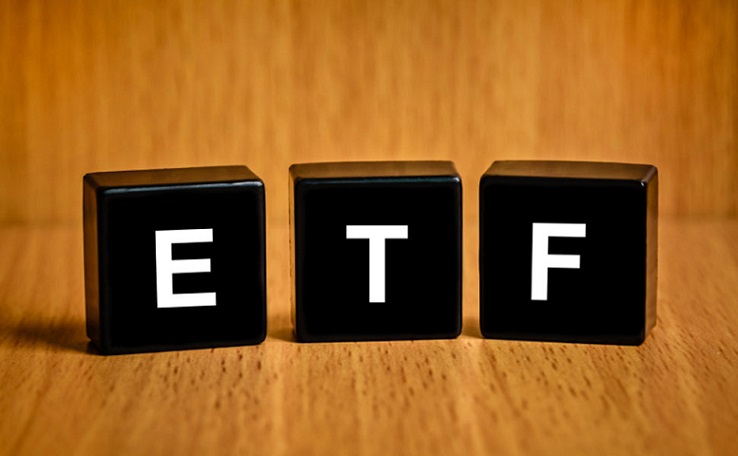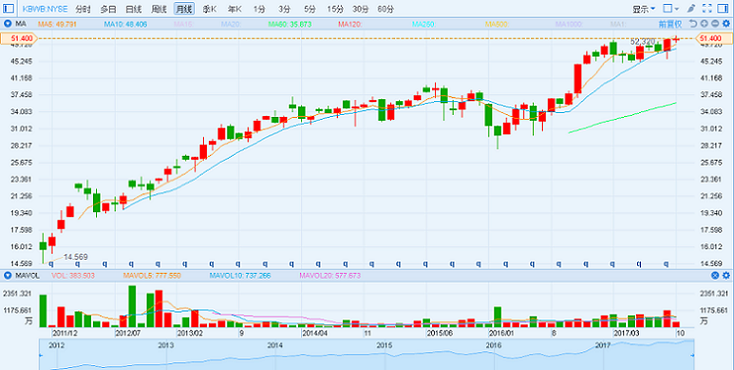
In early October, Marc Pouey, a senior U.S. equity strategist at Bank of America Merrill Lynch, said that even as the bull market was nearing its end, there were still investment opportunities in the financial sector because of its low current trading price.
According to individual goals and risk-taking ability, the choice of investment strategy should also be different. Generally speaking, investment banking ETF is one of the ways to invest in the financial sector relatively directly to the insurance industry.
The following ETF offers a diversified portfolio to help you reap benefits in the financial sector.
1. KBWB:Full name PowerShares KBW Bank Portfolio
Generally speaking, ETF, which has invested in the giant Bank of America Corporation, covers a wide range of areas, including insurance, investment companies and other financial business-related companies.
But KBWB, the ETF's portfolio, is one of the few that specializes in big American banks and some big regional banks.
Its shares have risen more than 7 per cent since September and now have a market capitalization of $300m. Since it went public in 2011, it has risen by more than 250%.

(KBWB goes on sale until K-line this month)
KBWB covers only 24 stocks, including the "big four American banks": Bank of America Corporation, JPMorgan Chase & Co, Citibank and Wells Fargo & Co. The shares of these four companies account for 32% of the ETF.
In addition, the market capitalization weighting system modified by KBWB avoids excessive weight imbalance to some extent and helps to reduce the risk of a single stock. There are some regional banks, although the market capitalization is very small, but still have considerable weight. Bank of America Corporation, for example, ranks first with a market capitalization of $276.9 billion, with a weighting of 8.1 per cent, while American Merchant Bank, headquartered in Buffalo, New York, has a market capitalization of just $24.4 billion, but with a weighting of 4 per cent.
2. IYG: full name iShares room. Financial Services ETF
Compared with the above ETF, IYG has a longer investment reach, not only involving commercial banks, but also investing in some asset management companies, even credit card companies, and so on.
This ETF is an option for companies that want to invest in banking or have the same upwind as banking.
Its shares have risen more than 7 per cent since September and now have a market capitalization of $1.5 billion. Since it went public in 2012, it has risen by more than 190%.

(IYG goes on sale until K-line this month)
The "big four US banks" are included in IYG's portfolio, accounting for nearly 30 per cent. 55% of its assets are invested in investment bank stocks.
IYG has also invested in stocks like Visa and MasterCard Inc, which have benefited from the overall economic recovery and the widespread use of credit cards. In addition, IYG has invested in companies such as Goldman Sachs Group and Morgan Stanley, which provide loans to corporate customers like ordinary banks, underwrite stocks and debt, and provide investment management services.
This portfolio can protect against the possible risk of a single investment bank stock.
3. KRE: full name SPDR seam Regional Banking ETF
In addition to simply investing in large banks, some growth investors may also be interested in relatively small bank stocks.
KRE adopts the equal weight method and adjusts the weight of the portfolio through rebalancing to avoid the imbalance in which the weight of a single stock is too high.
Its shares have risen more than 9 per cent since September and now have a market capitalization of $3.6 billion. It has risen by more than 157% since it went public in 2012.

(KRE goes on sale until K-line this month)
Over the past decade or so, the size of commercial banks has shrunk sharply, from 7,870 in 2002 to 5,102 in 2016. The financial crisis of 2007-2009 eliminated a number of relatively weak banks. In addition, the merger of larger regional banks and the acquisition of smaller banks is also one of the reasons for the decrease.
The attraction of funds like KRE is that they cover a wide range of stocks, such as KRE, which covers more than 100 bank stocks, mostly small and medium-sized companies.
Of course, it is true that there are certain risks, because the operating conditions of regional banks are closely related to the local regional economy, with ups and downs. Given its national coverage, the risk of this single region has also been reduced to some extent.
4. XLF: full name Financial Select Sector SPDR Fund
In terms of the size of assets under management, XLF is undoubtedly the largest financial ETF at present.It has $28.2 billion in assets under management, more than four times that of its similar fund, VFH (Vanguard Financials ETF).
Its shares have risen more than 7 per cent since September and now have a market capitalization of $21.3 billion. XLF was the first to go public, and the stock price trend indicated that it was relatively stable as a whole. However, in terms of trading volume, the ETF only began to become active in 2009. It has risen nearly 130% since 2012.

(XLF goes on sale until K-line this month)
Compared with the ETF mentioned aboveIt invests in more diversified companies, which means that banks may account for a relatively small proportion of shares.
Investment banking shares account for 44 per cent of XLF's assets, most of which come from the "big four", with a combined weighting of 32 per cent. Although JPMorgan Chase weighs 10.6% of the big four banks, it is still lower than Buffett's Berkshire Hathaway, ranking first at 11.3%, almost occupying the share of "diversified financial services" in the XLF configuration. In addition, 20 per cent of XLF assets are invested in insurers such as Chubb Ltd and AIG, while some assets, like IYG, are invested in companies and capital areas such as consumer finance.
Although insurers are very different from banks, they can also benefit from investing their money in high-yield bonds when interest rates rise.
It is worth mentioning that the s & p 500 Commercial Banks Industry Index is up 7 per cent since September, based on a close of 417.8 on august 31st and 449.8 on Oct. 19, according to Bloomberg data.

(screenshot source: Bloomberg)
In addition, the four banking giants Bank of America Corporation, JPMorgan Chase & Co, Citibank and Wells Fargo & Co have risen 11%, 8%, 7% and 4.76% respectively since September, compared with 4.25% for the S & P 500 index over the same period.
As the US economy improves, the Fed will continue to raise interest rates, which will help boost banks' net interest yields. Although raising interest rates may reduce lending activity, on the whole, raising interest rates is a positive policy for bank stocks. (compiled / Wu Dongxia)
Risk Tip: the speeches of the authors or guests shown above have their own specific positions, and investment decisions need to be based on independent thinking. Futu will try its best but cannot guarantee the accuracy and reliability of the above content, and will not bear any loss or damage caused by any inaccuracy or omission.
